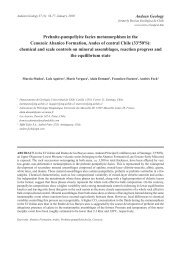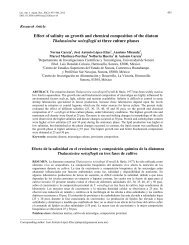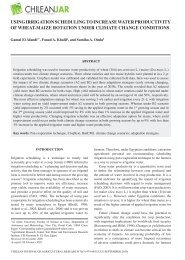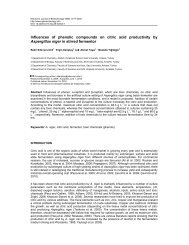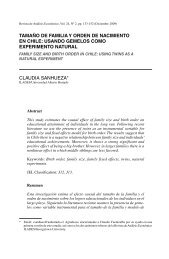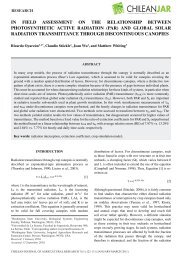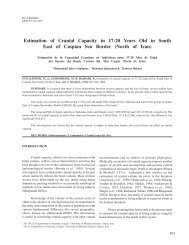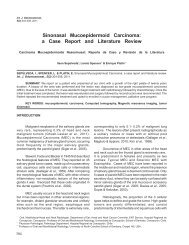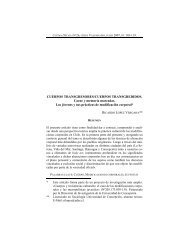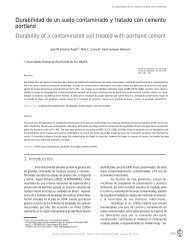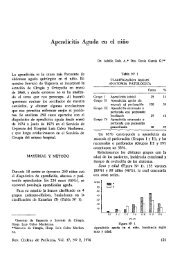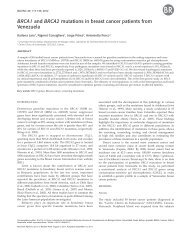Sex Determination in Mandibles in the First Year of Life by ... - SciELO
Sex Determination in Mandibles in the First Year of Life by ... - SciELO
Sex Determination in Mandibles in the First Year of Life by ... - SciELO
Create successful ePaper yourself
Turn your PDF publications into a flip-book with our unique Google optimized e-Paper software.
Int. J. Morphol.,<br />
27(1):113-116, 2009.<br />
<strong>Sex</strong> <strong>Determ<strong>in</strong>ation</strong> <strong>in</strong> <strong>Mandibles</strong> <strong>in</strong> <strong>the</strong><br />
<strong>First</strong> <strong>Year</strong> <strong>of</strong> <strong>Life</strong> <strong>by</strong> a Quantitative Approach<br />
Determ<strong>in</strong>ación del <strong>Sex</strong>o en Mandíbulas en el Primer Año de Vida<br />
Mediante una Aproximación Cuantitativa<br />
*,**<br />
Iván Claudio Suazo Galdames; ** Daniela Alejandra Zavando Matamala & ** Ricardo Luiz Smith<br />
SUAZO, G. I. C.; ZAVANDO, M. D. A. & SMITH, R. L. <strong>Sex</strong> determ<strong>in</strong>ation <strong>in</strong> mandibles <strong>in</strong> <strong>the</strong> first year <strong>of</strong> life <strong>by</strong> a quantitative<br />
approach. Int. J. Morphol., 27(1):113-116, 2009.<br />
SUMMARY: Numerous studies have shown that skeletal characteristics vary among different populations. Several authors<br />
suggest that it is possible to determ<strong>in</strong>e sex through <strong>the</strong> anatomical evaluation <strong>of</strong> children mandible, however <strong>the</strong>re are few morphometrical<br />
studies conducted with such specimens. The purpose <strong>of</strong> this study was to analyze several mandibular dimensions and identify <strong>the</strong> ones<br />
that could be useful to perform sex differentiation <strong>in</strong> a sample <strong>of</strong> Brazilian young children. For this study we used 32 children dry<br />
mandibles <strong>of</strong> known sex, age rang<strong>in</strong>g from 0 to 1 year old. The mandibles perta<strong>in</strong> to <strong>the</strong> collection <strong>of</strong> <strong>the</strong> Skull Museum <strong>of</strong> <strong>the</strong> Universidade<br />
Federal de São Paulo (UNIFESP). The parameters <strong>in</strong>cluded bicondilar width, bigonial width, m<strong>in</strong>imum width and height <strong>of</strong> <strong>the</strong> mandibular<br />
ramus, gonion-gnation length, height <strong>of</strong> <strong>the</strong> mandibular symphysis and transverse and anteroposterior condylar dimensions. The SPSS<br />
program was used to carry on <strong>the</strong> discrim<strong>in</strong>ant function analysis and <strong>the</strong> T test (p
SUAZO, G. I. C.; ZAVANDO, M. D. A. & SMITH, R. L. <strong>Sex</strong> determ<strong>in</strong>ation <strong>in</strong> mandibles <strong>in</strong> <strong>the</strong> first year <strong>of</strong> life <strong>by</strong> a quantitative approach. Int. J. Morphol., 27(1):113-116, 2009.<br />
differentiation <strong>in</strong> subadults’ mandibules through shape<br />
analysis <strong>of</strong> <strong>the</strong> mandibular body with 81% accuracy. These<br />
results were discussed <strong>by</strong> Coqueugniot et al. (2002), who<br />
performed a similar study obta<strong>in</strong><strong>in</strong>g lower accuracy levels.<br />
Subsequently, Suazo et al. (2008a) developed a study with a<br />
sample <strong>of</strong> Brazilian mandibles and reported accuracy levels<br />
between 57.5 and 60.5% for sex determ<strong>in</strong>ation, with greater<br />
sensitivity for determ<strong>in</strong><strong>in</strong>g male, and conclude that it is<br />
necessary to carefully evaluate <strong>the</strong> methods <strong>of</strong> sex<br />
determ<strong>in</strong>ation from subadults mandibles <strong>in</strong> specific<br />
populations.<br />
Consider<strong>in</strong>g this background, <strong>the</strong> goal <strong>of</strong> this study<br />
is to determ<strong>in</strong>e several dimensions <strong>of</strong> mandibles <strong>in</strong> a sample<br />
<strong>of</strong> Brazilian children <strong>in</strong> <strong>the</strong> first year <strong>of</strong> life and analyze <strong>the</strong><br />
reliability <strong>of</strong> <strong>the</strong>se parameters <strong>in</strong> sex determ<strong>in</strong>ation with<br />
forensic purposes.<br />
MATERIAL AND METHOD<br />
We used 32 mandibles <strong>of</strong> Brazilian children between<br />
0 and 1 year-old, 20 males and 12 females. The mandibles<br />
belong to <strong>the</strong> Skull Museum collection <strong>of</strong> <strong>the</strong> Morphology<br />
and Genetics Department, Universidade Federal de São Paulo<br />
(UNIFESP), Brasil.<br />
The mandibles were separated from <strong>the</strong> skull, without<br />
morphological alterations and no evidence <strong>of</strong> trauma. Us<strong>in</strong>g<br />
a digital caliper (0.01mm) <strong>the</strong> follow<strong>in</strong>g measurements were<br />
taken:<br />
- Bicondilar width: Distance between <strong>the</strong> lateral poles <strong>of</strong> <strong>the</strong><br />
right and left mandibular head.<br />
- Bigonial width: Distance between <strong>the</strong> right and left mandibular<br />
angle.<br />
- M<strong>in</strong>imum width <strong>of</strong> <strong>the</strong> mandibular ramus: M<strong>in</strong>imum distance<br />
between <strong>the</strong> anterior and posterior edge <strong>of</strong> <strong>the</strong> mandibular ramus.<br />
- Height <strong>of</strong> <strong>the</strong> mandibular ramus: distance between <strong>the</strong> deepest<br />
po<strong>in</strong>t <strong>of</strong> <strong>the</strong> mandibular <strong>in</strong>cisure and <strong>the</strong> deepest part <strong>of</strong> <strong>the</strong><br />
antegonial <strong>in</strong>cisure, is measured <strong>in</strong> <strong>the</strong> right and left mandibular<br />
ramus.<br />
- Gonion-gnation length: Distance between <strong>the</strong> mandibular angle<br />
and <strong>the</strong> lowest po<strong>in</strong>t <strong>of</strong> <strong>the</strong> mandibule <strong>in</strong> <strong>the</strong> anterior median l<strong>in</strong>e.<br />
It is measured from <strong>the</strong> right and left mandibular angle.<br />
- Height <strong>of</strong> <strong>the</strong> mandible: Maximum length <strong>of</strong> <strong>the</strong> mandibular<br />
median l<strong>in</strong>e.<br />
- Transverse dimension <strong>of</strong> <strong>the</strong> mandibular head: Distance<br />
between lateral pole and medial pole <strong>of</strong> <strong>the</strong> mandibular head. It<br />
is measured on <strong>the</strong> right and left side.<br />
- Anteroposterior dimension <strong>of</strong> <strong>the</strong> mandibular head: maximum<br />
distance between <strong>the</strong> anterior and posterior face <strong>of</strong> <strong>the</strong><br />
mandibular head, measured at right and left sides.<br />
For some mandibles, difficult or doubtful<br />
measurements were excluded and only <strong>the</strong> data obta<strong>in</strong>ed were<br />
submitted to <strong>the</strong> t test for <strong>in</strong>dependent samples, p
SUAZO, G. I. C.; ZAVANDO, M. D. A. & SMITH, R. L. <strong>Sex</strong> determ<strong>in</strong>ation <strong>in</strong> mandibles <strong>in</strong> <strong>the</strong> first year <strong>of</strong> life <strong>by</strong> a quantitative approach. Int. J. Morphol., 27(1):113-116, 2009.<br />
Table I. Descriptive statistics, and p value <strong>of</strong> Wilks' lambda <strong>of</strong> <strong>the</strong> l<strong>in</strong>ear dimensions analyzed <strong>in</strong> 32 mandibles <strong>of</strong> children aged<br />
between 0 and 1 year old <strong>of</strong> <strong>the</strong> collection <strong>of</strong> UNIFESP.<br />
<strong>Sex</strong> n Mean SD Sig. Wilks' lambda<br />
• B icondilar width<br />
Male 20 63.1350 6.92755<br />
Female 12 63.1275 8.27786<br />
.998 .999<br />
• B igonial width<br />
Male 20 50.4790 6.83989<br />
Female 12 49.1158 6.57738<br />
.584 .994<br />
• H eight <strong>of</strong> <strong>the</strong> rigth mandibular ramus<br />
Male 20 19.2510 3.96959<br />
Female 12 18.2325 3.26029<br />
.460 .978<br />
• H eight <strong>of</strong> <strong>the</strong> left mandibular ramus<br />
Male 20 18.8530 3.84045<br />
Female 12 18.0408 3.28720<br />
.547 .990<br />
• M <strong>in</strong>imum width <strong>of</strong> <strong>the</strong> rigth mandibular ramus Male 19 16.9611 2.38965<br />
Female 12 17.1700 2.56457<br />
.819 .996<br />
• M <strong>in</strong>imum width <strong>of</strong> <strong>the</strong> left mandibular ramus Male 19 17.1247 2.31920<br />
Female 12 17.2933 2.35827<br />
.846 .998<br />
• R ight gonion-gnation<br />
Male 20 40.1245 5.37346<br />
Female 12 38.5642 5.60068<br />
.440 .986<br />
• L eft gonion-gnation<br />
Male 20 38.9930 5.37810<br />
Female 12 38.2550 5.33035<br />
.709 .997<br />
• T ransverse dimension <strong>of</strong> <strong>the</strong> rigth mandibular Male 19 9.0995 1.46108<br />
head Female 12 9.2633 1.34999<br />
.757 .993<br />
• T ransverse dimension <strong>of</strong> <strong>the</strong> left mandibular Male 20 9.2180 1.60052<br />
.689 .999<br />
head Female 12 9.0008 1.21001<br />
• A nteroposterior dimension <strong>of</strong> <strong>the</strong> rigth Male 18 5.4917 .77062<br />
mandibular head Female 12 5.4425 .77879<br />
.866 .999<br />
• A nteroposterior dimension <strong>of</strong> <strong>the</strong> left<br />
Male 19 5.8226 .74800<br />
mandibular head Female 12 5.5325 .83567<br />
.323 .973<br />
• H eight <strong>of</strong> <strong>the</strong> mandible<br />
Male 20 13.678 2.6423<br />
Female 12 12.991 2.6479<br />
.482 .990<br />
on 38 landmarks and have concluded that no sexual<br />
dimorphism can be determ<strong>in</strong>ed <strong>in</strong> subadults mandibles.<br />
Much higher accuracy <strong>in</strong>dexes (70-90% accuracy)<br />
were obta<strong>in</strong>ed <strong>by</strong> Schutkowski, who has conducted a<br />
comb<strong>in</strong>ed metric analysis from different parts <strong>of</strong> <strong>the</strong> skeleton,<br />
<strong>in</strong>clud<strong>in</strong>g <strong>the</strong> mandible. However, whenever <strong>the</strong> skeleton<br />
rema<strong>in</strong>s are not complete and assessment must be made from<br />
<strong>the</strong> mandible only, our results recommend <strong>the</strong> use <strong>of</strong> a nonmetric<br />
or qualitative analysis for <strong>the</strong> diagnosis <strong>of</strong> sex <strong>in</strong><br />
subadults, this is also applied when specific populations'<br />
skeletal rema<strong>in</strong>ders exist or <strong>in</strong> those that one suspects <strong>of</strong><br />
nutritional alterations (Suazo et al., 2008b, 2008c).<br />
In conclusion, mandibles <strong>in</strong> <strong>the</strong> first year <strong>of</strong> life<br />
present little sexual dimorphism and is a quantitative<br />
approach seems not to be <strong>the</strong> best tool for sex identification<br />
with forensic purposes.<br />
SUAZO, G. I. C. .; ZAVANDO, M. D. A. & SMITH, R. L. Determ<strong>in</strong>ación<br />
del sexo en mandíbulas en el primer año de vida mediante<br />
una aproximación cuantitativa. Int. J. Morphol., 27(1):113-<br />
116, 2009.<br />
RESUMEN: Numerosos estudios han demostrado que las<br />
características esqueletales varían en las dist<strong>in</strong>tas poblaciones. Diversos<br />
autores <strong>in</strong>dican que es posible la determ<strong>in</strong>ación del sexo en<br />
base a mandíbulas <strong>in</strong>fantiles; s<strong>in</strong> embargo, existen escasos estudios<br />
morfométricos realizados en mandíbulas de niños brasileros.<br />
El propósito de este estudio fue analizar dist<strong>in</strong>tas dimensiones de<br />
mandíbulas y determ<strong>in</strong>ar aquellas de utilidad en el diagnóstico<br />
forense del sexo, en población <strong>in</strong>fantil brasilera. Se utilizaron 32<br />
mandíbulas de niños brasileros de entre 0 y 1 año de edad, de sexo<br />
conocido, pertenecientes a la colección de cráneos de la<br />
Universidade Federal de São Paulo (UNIFESP). Las mediciones<br />
mandibulares <strong>in</strong>cluyeron ancho bicondilar, ancho bigonial, ancho<br />
mínimo y altura de la rama mandibular, longitud gonion- gnation,<br />
altura de la sínfisis mandibular y las dimensiones transversa y<br />
anteroposterior del cóndilo. Los datos obtenidos fueron sometidos<br />
115
SUAZO, G. I. C.; ZAVANDO, M. D. A. & SMITH, R. L. <strong>Sex</strong> determ<strong>in</strong>ation <strong>in</strong> mandibles <strong>in</strong> <strong>the</strong> first year <strong>of</strong> life <strong>by</strong> a quantitative approach. Int. J. Morphol., 27(1):113-116, 2009.<br />
al t test (p




